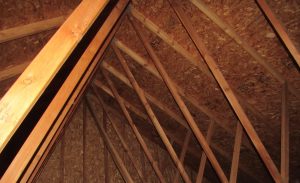Home Inspections St. Paul | Home Inspector
651-368-7971

Attics might not spook you, but they can entertain some pretty unsavory characters. That’s why attics are always inspected unless there’s no reasonable way to gain access. You never know what you’ll find, and some secrets need a quick remedy.
Below are the components that the certified home inspector will be inspecting:
- Insulation- Attic insulation has a major job to do, and it does it inexpensively. Unfortunately, many homes, if not most, need more of the fluffy stuff to keep the house buttoned up and comfortable. An attic inspection can not only show whether there’s adequate insulation, it can also show if it’s installed correctly.
- Mold– That dank, dusty smell in the attic might be more than age and an accumulation of cobwebs. Several possible factors could contribute to damp conditions. Left unchecked, mold can thrive. Poor ventilation, roof leaks and even water standing in the basement can contribute to high moisture levels in the attic. And what surprises some homeowners is that improper insulation can, too. Mold can cause allergy flare-ups, and some molds are toxic. The inspector will look for all of these indications when checking for mold.
- Rodents- When attics are uninhabited, neighborhood critters might move in. Sometimes, they bring friends, and sometimes they come back year after year when the weather is cold. Rats, mice, bats, raccoons, and squirrels are no respecter of households, rich or poor. If there’s a way in, you can bet they’ll find it. In winter, it’s even more likely to spot a mom with new babies or maybe entire critter families. After all, it’s safe shelter from the cold. Animals in the attic can gnaw on wiring, tear apart ductwork, leave droppings and some make their way into the living spaces of the house.
- Leaks- You’d expect to find a hot attic in July. But if that part of the house is unreasonably warm in January, there’s a problem. Costly heated indoor air rises. If there’s nothing to stop the transfer, it’ll head straight to the attic. Air leaks, such as gaps between joists and around openings for wiring, give the warm air a straight path to the attic. Poor insulation can do the same, even if there aren’t any air leaks. A warm attic in winter indicates that the home is leaking expensive heated air.
- Electrical– It takes a lot more Romex to run up through the walls, into the attic and back down into the living space again. But that’s how a lot of electricians prefer to wire a house. It’s often easier than fishing wire horizontally through finished interior walls. But shortcuts can also land in the attic. Who’s going to notice, anyway? Unsafe junction boxes, wiring covered with insulation, exposed light fixtures and a host of other electrical problems might lurk in an attic. And most of them are fire hazards that need attention ASAP.
- Water Intrusion- In most cases, we won’t need an umbrella to inspect an attic. But every once in a while, we find a house that acts more like a sieve than a fortress. Question is, where does all the water come from? Dripping water in an attic might mean the roof is leaking. That’s the most obvious culprit. But heavy condensation issues can mimic a roof leak so cleverly they can sometimes go overlooked. Installation that’s installed incorrectly, leaks and other water issues in the basement or crawlspace and HVAC condensation can create a humid attic environment. The inspector will check the roof decking closely to be sure the raindrops are coming from outside, and not inside.
As said above, there are many important components that go into an attic and what common issues can be found with them. Our inspector will give a thorough inspection of the attic and finish it off with a detailed report with picture that will be provided to you in 24 hours of the completed inspection. Give us a call today!
Home Inspections St. Paul | Home Inspector